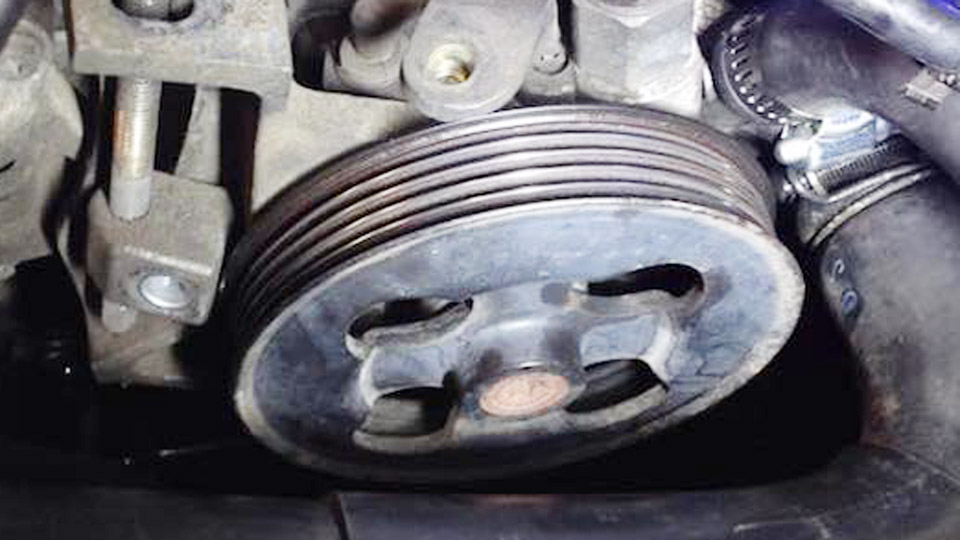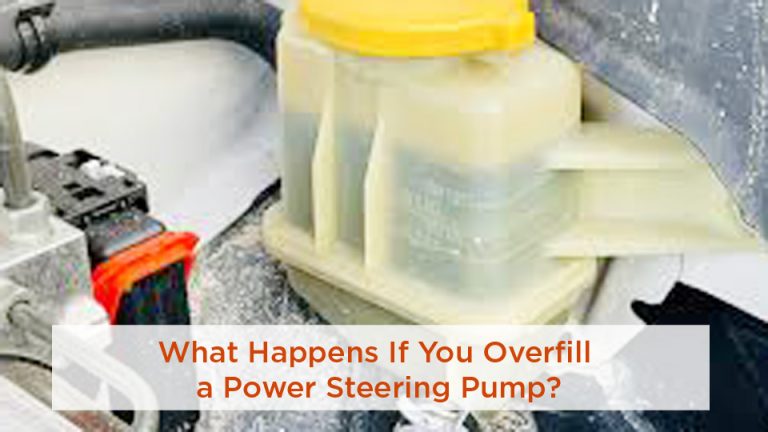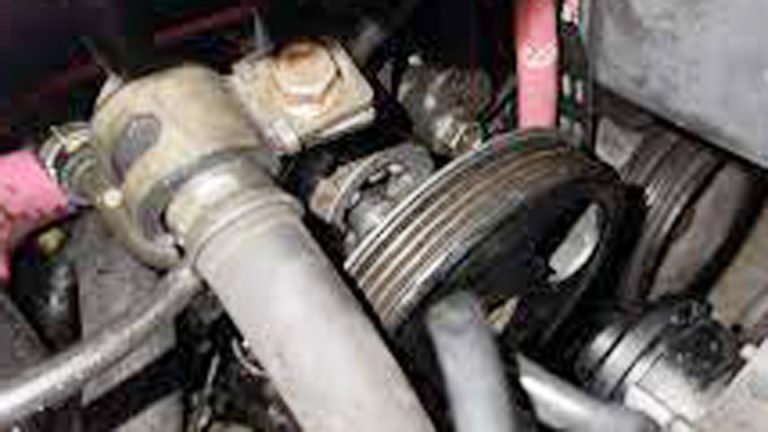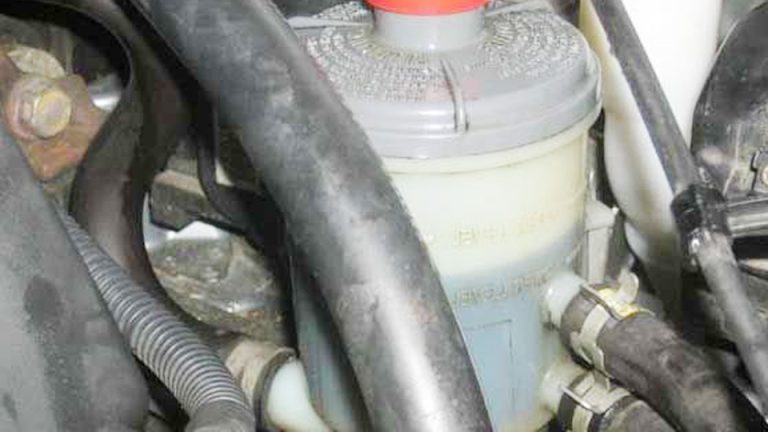You’re cruising down the road when suddenly the steering wheel feels heavier, maybe you even hear a whining noise every time you turn. A lot of drivers chalk it up to low fluid or normal wear, but in many cases, it’s the power steering pump starting to fail. So, what happens if the power steering pump goes out? From my experience under the hood, this small part makes a huge difference in how safe and comfortable your car is to drive. I’ve seen plenty of car owners push their luck, only to end up with stiff steering and higher repair bills because they ignored the early warning signs.

Image by ace88bull
Understanding the Power Steering Pump: What It Is and Why It Matters
You’re cruising down the highway, effortlessly navigating turns with just a flick of the wrist. That’s the magic of the power steering pump at work. I’ve pulled these pumps apart countless times, and they’re essentially the heart of your hydraulic steering system.
What Does the Power Steering Pump Do?
The power steering pump is a belt-driven component, usually mounted on the engine, that pressurizes hydraulic fluid to assist in turning your wheels. It takes the rotational energy from the engine via the serpentine belt and converts it into hydraulic pressure.
This pressure pushes fluid through hoses to the steering rack or gearbox, making steering lighter and more responsive. In modern cars, some are electric, but most US vehicles still use hydraulic pumps, especially in trucks and older models like the Ford F-150 or Chevy Silverado that I see daily.
From my experience, a healthy pump operates at around 1,000 to 1,500 PSI, depending on the vehicle. Without it, you’d be muscling the wheel like in those old manual-steering classics—fine for parking lot maneuvers, but exhausting on long drives.
Why the Power Steering Pump Matters for Safety, Performance, and More
Safety-wise, a failing pump can turn a simple lane change into a hazard. I’ve had customers come in after nearly sideswiping someone because their steering locked up mid-turn. Performance takes a hit too; uneven steering leads to poor handling, especially at low speeds. Cost is another factor—ignoring issues can damage the rack, hoses, or even the belt, turning a $300 fix into a $1,000 nightmare.
Reliability is key in the US market, where we drive everything from compact Hondas to heavy-duty Rams. A good pump improves fuel efficiency slightly by reducing engine load, but more importantly, it prevents premature wear on tires and suspension. In my shop, I’ve seen pumps last 100,000 miles with proper care, but neglect them, and you’re looking at early failure.
Signs Your Power Steering Pump Is Failing
Spotting trouble early can save you a tow truck bill. I’ve diagnosed hundreds of these, and the symptoms are pretty consistent across brands like GM or Toyota.
Common Symptoms of a Bad Power Steering Pump
First off, listen for noises. A whining or groaning sound when you turn the wheel, especially at low speeds, is a classic sign. I remember a ’12 Chevy Malibu I worked on—the owner thought it was the alternator, but it was the pump cavitating from low fluid.
Steering feel changes too. If the wheel feels stiff or jerky, particularly when parking, that’s the pump struggling to build pressure. Leaks are another giveaway; check for red or brown fluid puddles under the car near the engine. Overheated fluid smells burnt and looks foamy in the reservoir.
Other red flags include slow response from the steering wheel or vibrations during turns. If your pump seizes, the serpentine belt might slip or break, stalling accessories like the alternator.
How to Diagnose Power Steering Pump Issues at Home
Grab a flashlight and pop the hood. Check the fluid level in the reservoir—low levels often mimic pump failure. Top it off with the right fluid (ATF for some, specific PS fluid for others) and see if symptoms improve.
Start the engine and turn the wheel lock-to-lock while listening. If the whine persists, use a mechanic’s stethoscope on the pump housing for grinding noises. I’ve used this trick on Dodges to pinpoint bearing wear without disassembly.
If you’re tech-savvy, hook up a pressure gauge to the pump’s output line. Normal readings are 1,000+ PSI; anything lower points to internal failure.
What Happens When the Power Steering Pump Fails Completely
So, what happens if the power steering pump goes out entirely? It’s not catastrophic like a blown engine, but it’s no picnic either.
Immediate Effects on Steering and Driving
Steering becomes manual and heavy, like arm-wrestling your car. At highway speeds, it’s manageable, but low-speed maneuvers? Forget easy parking or tight turns. I’ve driven a failed pump on a test run—it’s doable short-term, but risky in traffic.
The pump might overheat and seize, dragging the belt and causing it to wear or snap. This could shut down the water pump or alternator, leading to overheating or a dead battery.
Long-Term Damage If Ignored
Prolonged driving with a bad pump contaminates the system with metal shavings, ruining the rack and hoses. Fluid leaks accelerate corrosion. In one case, a customer’s ignored whine led to a $2,000 rack replacement on their Jeep.
Safety risks escalate—sudden loss of assist can cause accidents. Plus, it hurts fuel efficiency as the engine works harder against the seized pump.
When and Why You Need to Replace Your Power Steering Pump
Replacement isn’t always immediate, but don’t wait for total failure.
Triggers for Replacement: Mileage, Wear, and Failures
Most pumps last 100,000 miles, but harsh conditions like towing or city driving shorten that. Replace if diagnostics confirm low pressure or if rebuilding isn’t viable—pumps aren’t user-serviceable like brakes.
Why replace? To restore smooth steering, prevent system-wide damage, and maintain resale value. I’ve swapped pumps on high-mileage vehicles to pass inspections.
Factors Influencing Replacement Decisions
Consider vehicle age and use. For daily drivers, fix ASAP; for classics, weigh costs. In the US, parts are readily available at AutoZone or O’Reilly, making DIY feasible for many.
OEM vs Aftermarket Power Steering Pumps: Which to Choose?
Choosing parts is where my shop experience shines. I’ve installed both, and each has its place.
Pros and Cons of OEM Power Steering Pumps
OEM (Original Equipment Manufacturer) pumps from brands like GM or Ford match factory specs perfectly. Pros: Superior fit, longer lifespan (often 100k+ miles), and warranty coverage. Cons: Pricey—$300-$600 just for the part. They’re reliable for premium vehicles.
Pros and Cons of Aftermarket Options
Aftermarket from companies like ACDelco, Cardone, or Gates are cheaper ($100-$400) and widely available. Pros: Cost savings, sometimes improved designs. Cons: Variable quality; some fail prematurely. I’ve had good luck with remanufactured units, but always check reviews.
Comparison Table: OEM vs. Aftermarket Power Steering Pumps
| Aspect | OEM | Aftermarket |
|---|---|---|
| Price Range | $300-$600 | $100-$400 |
| Lifespan | 100,000+ miles | 50,000-100,000 miles |
| Fit & Compatibility | Perfect for specific models (e.g., Chevy Tahoe) | Good, but check vehicle fit (e.g., universal for Fords) |
| Warranty | 2-3 years | 1-2 years |
| Brands | GM, Ford, Toyota | ACDelco, Bosch, Melling |
| Availability | Dealerships | Auto parts stores nationwide |
In the US, for a ’15 Ram 1500, I’d go OEM if it’s under warranty; otherwise, a quality aftermarket like BBB Industries saves bucks without sacrificing much.
Step-by-Step Guide to Replacing a Power Steering Pump
I’ve done this job on everything from Subarus to Dodges. It’s straightforward with the right tools, but messy—wear gloves.
Tools and Safety Precautions You’ll Need
Tools: Socket set, pulley puller, line wrenches, drain pan, new fluid. Safety: Disconnect battery, wear eye protection, jack up if needed. Work on a cool engine to avoid burns.
Detailed Installation Steps
- Drain the system: Remove the return hose from the reservoir and drain into a pan. Turn the wheel to expel fluid.
- Remove the belt: Loosen the tensioner with a wrench and slip off the belt from the pump pulley.
- Disconnect hoses: Use line wrenches on pressure and return lines to avoid stripping fittings. Plug lines to prevent drips.
- Remove the pump: Unbolt the mounting brackets (usually 3-4 bolts). On some, like Toyotas, remove the pulley first with a puller.
- Install new pump: Bolt it in, reinstall pulley if removed, reconnect hoses tightly.
- Refill and bleed: Add fresh fluid, start engine, turn wheel lock-to-lock to bleed air. Check for leaks.
- Test drive: Feel for smooth steering; top off fluid as needed.
This took me about 2 hours on a lifted truck once—patience is key.
Vehicle-Specific Tips for US Models
For Ford F-Series, watch the tight engine bay. Chevys often need pulley tools. Always match part numbers for compatibility.
Common Mistakes to Avoid When Replacing Your Power Steering Pump
I’ve seen DIYers botch this and end up back in the shop.
Over-tightening hoses strips threads—use torque specs. Forgetting to bleed air causes whining noises post-install. Using wrong fluid? Big no—mixing types foams and damages seals.
Not flushing the system leaves debris, shortening the new pump’s life. And skipping the pulley alignment can chew up belts fast.
One anecdote: A buddy installed a pump upside down on his Jeep—hilarious, but it leaked everywhere. Double-check orientation.
Maintenance Tips to Prolong Your Power Steering Pump’s Life
Keep it running smooth with routine care.
Check fluid monthly—top off to prevent cavitation. Change fluid every 50,000 miles or if it looks dirty. Inspect hoses for cracks; replace if swollen.
Avoid max turns when parked—it strains the pump. Use quality fluid like Dexron for GM vehicles.
In my experience, flushing the system annually on high-mileage cars adds years to the pump.
How to Identify Genuine Power Steering Pumps and Avoid Fakes
Counterfeits flood the market, especially online.
Look for holograms or serial numbers on OEM parts. Genuine ACDelco has laser-etched logos; fakes feel cheap.
Buy from reputable US sellers like RockAuto or dealerships. Check packaging—real ones have detailed instructions.
I’ve spotted fakes by weight; knockoffs are lighter. Test fit before install—if it’s off, return it.
Costs Involved in Power Steering Pump Replacement
Expect $500-$900 total in the USA, with parts $100-$600 and labor $200-$500. DIY saves labor, but factor in tools.
For a Honda Accord, it’s cheaper; a heavy-duty truck like a Silverado pushes higher due to access.
Shop around—independent garages often beat dealership prices.
Conclusion
The power steering pump might seem minor, but it’s vital for safe, enjoyable driving. If it goes out, you’re in for tough steering and potential breakdowns, but catching signs early keeps things simple. Make smarter decisions by opting for quality parts—OEM for longevity, aftermarket for budget—and always maintain fluid levels. After any steering work, align your wheels; it prevents uneven tire wear and keeps handling crisp. Drive safe out there!
FAQ
What Are the First Signs of Power Steering Pump Failure?
Early signs include whining noises when turning, stiff steering at low speeds, and fluid leaks under the car. I’ve caught these on routine checks, saving bigger repairs.
How Long Does a Power Steering Pump Last?
Typically 100,000 miles with good maintenance, but factors like towing or leaks can shorten it to 50,000. In my shop, we’ve seen some go 150,000 on well-cared-for vehicles.
Can I Drive My Car If the Power Steering Pump Is Bad?
Short distances yes, but it’s unsafe and can damage other components. I once limped a car home with no assist—exhausting and risky.
What’s the Difference Between Hydraulic and Electric Power Steering Pumps?
Hydraulic uses fluid and belts; electric is motor-driven for better efficiency. Most US trucks stick with hydraulic for torque, but newer cars go electric.
How Do I Choose the Right Power Steering Fluid?
Check your manual—ATF for some Fords, specific PS fluid for others. Wrong type causes foaming and pump damage; I’ve flushed systems ruined by mismatches.



